The Effect of Night Sky Polarization Originated by the Sun on the Light-Trap Catch of Insects in Nebraska and North Carolina States (USA)
László Nowinszky1*, Miklós Kiss1, János Puskás1 and András Barta2
1Eotvos Lorand University, Savaria Campus Savaria Science Centre, Hungary
2Drem Innovation and Consulting Ltd, Hungary
Submission: November 10, 2018; Published: January 11, 2019
*Corresponding author: László Nowinszky, Eotvos Lorand University, Savaria Campus Savaria Science Centre, 9700 Szombathely Károlyi Gáspár Square 4. Hungary
How to cite this article: László N, Miklós K, János P, András B. The Effect of Night Sky Polarization Originated by the Sun on the Light-Trap Catch of 002 Insects in Nebraska and North Carolina States (USA). Mod Appl Bioequiv Availab. 2019; 4(2): 555633. DOI: 10.19080/MABB.2019.04.555633
Abstract
This paper treads with the night sky polarization springs from the Sun in relationship with the success of light trap catch of insects in Nebraska and North Carolina states between 1994 and 2017. The Sun’s sky polarization can be seen for the insects all the nights. The sky polarization is dissimilar from each of the midnight hours of catching periods. We suggest that the most successful catch of each species has different polarization values. We conclude from this indisputable reality that the apex of the swarming of each species is closely related to a given value of the polarization in the nightly sky, which is hangs together to the calendar date.
Keywords: Night sky; Polarization; Sun; Light-traps; Nebraska; North Carolina
Introduction
Verkhovskaya [1] announced the first time that arthropods (Arthropoda) are able to distinguish between polarized- and not polarized lights. lights. The entomologists, however, noticed so far on daytime active insects or at dusk. Dacke et al. [2] wrote that the Bogong Moths (Agrotis infusa Boisduval) can use the polarized light pattern originated by Sun and the Moon and perhaps the Milky Way.
Horváth and Varjú [3] observed that several aquatic insects are liable to use the night sky polarization patterns
The attraction of night flying insects to the polarized moonlight was examined by Hungarian entomologists. Nowinszky et al. [4] found that some night flying beetles (Coleoptera), bugs (Heteroptera), caddisflies (Trichoptera) and moths (Lepidoptera) species are able to use the Sun’s and Moon’s night sky polarization for their spatial orientation.
Materials
The light traps of North Carolina and Nebraska supplied a huge scientific material over the past two decades for entomological basic research, and plant protection prognostics work for the farmers. We could investigate only the data of five species, because enough catch data were found (Table 1).

Notes: Years: Different number of light-traps were operating in different years.
Data: Several light-traps could be operated overnight.
In this investigation the BL traps data of USA States of North Carolina and Nebraska were used. These were downloaded from North Carolina Pest News on the Internet and the North Carolina Cooperative Extension Service websites. The light-trap collecting data of Nebraska State were from the years 2000 and 2017 and the North Carolina State traps’ material was found in years between 1994 and 2010. In these states, 15 W BL traps were in operation. The data collection was published several times each year for farmers, in order to utilize these data in their plant protection works.
Methods
The relative catch values were computed from the number of catching individuals of each investigated species for sampling nights per year to compare the differing sampling data, The RC was defined as the quotient of the number of trapping individuals during a sampling time unit (1 night) per the average catch of individuals within the same swarming relating to the same time unit. For example, when the actual catch is equal to the average individual number caught in the same swarming, the RC is 1 [5]. We have examined the effectiveness of night sky polarization of Sun and Moon for the catch of individuals.
We calculated the degree of polarization of clear sky lit by the Sun and by the Moon separately at the Zenith for the geographical coordinates of Lenoir (North Carolina) and Clay City (Nebraska). For this we first determined the celestial position of the Sun and the Moon for every point in time of the above interval for a geographic position of 35° 54’ 50” N and 81° 32’ 20” W at Lenoir and 40° 31’ 20” N and 98° 3’ 18” W at Clay City. We then calculated the degree of polarization of the clear sky at the Zenith by using the Berry-method [6]. For this calculation we assumed a neutral point distance of 27.5° and for the sake of simplicity a maximum of degree of polarization of 100%. Note, that during this paper we did not use the absolute degree of polarization, instead only their relative ratios, so assuming 100% maximum degree of polarization does not influence our end results, despite being a non-real scenario. We had only one collection data from a whole night, so we worked with the polarization data calculated for 23 hours (GT) [4].
The daily values of the night sky polarization originated by the Sun showed significant differences at every 23 hours. Therefore, we looked into the question of whether polarization values can modify of the catching of examined insect species.
We have investigated the influence of Sun’s and Moon’s night sky polarization for the trapping individuals. We did not receive significant values the night sky polarization of Moon, so these results are not published. We depicted on figures the results of night sky polarization originated by the Sun and the connection with catching data. Figures also show the confidence intervals.
Results and Discussion
The efficiency of night sky polarization originated by the Sun for the caught individuals of examined species are shown in Figure 1-6. The Sun is over the horizon only in the first and last trapping hours, so it is there at dusk and dawn. Nevertheless, the Sun’s effects of the sky polarization on the examined species are larger than the Moon’s influence. In our previous paper [4] we processed the catching data of only one species (Turnip Moth, Agrotis segetum Denis et Schiffermüller), but there we had only hourly catch data. We established in the study, that the sky polarization caused by the Sun have an influence only in the period of dusk and dawn. The night sky polarization originated by the Sun can be seen for insects, so have an influence in the period of all the nights.

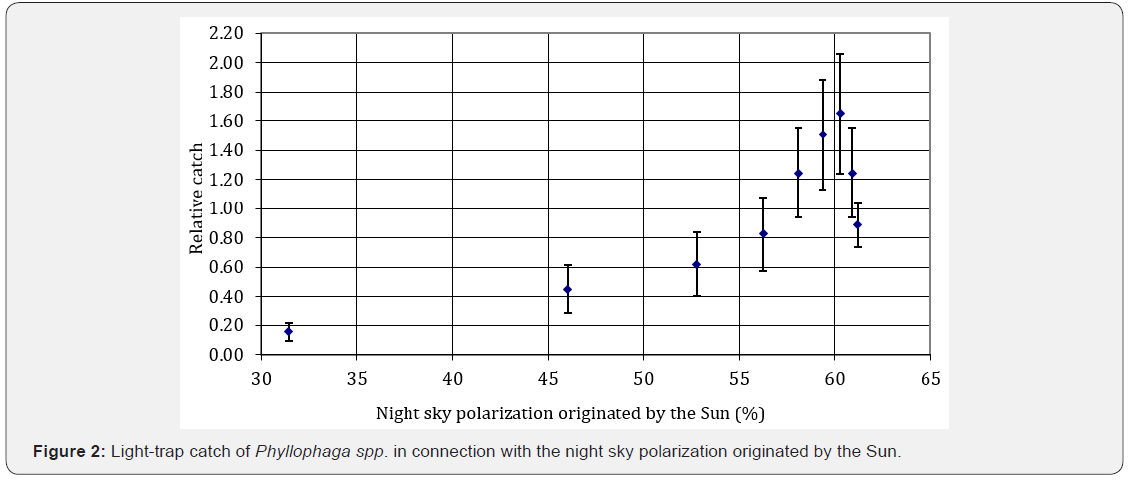
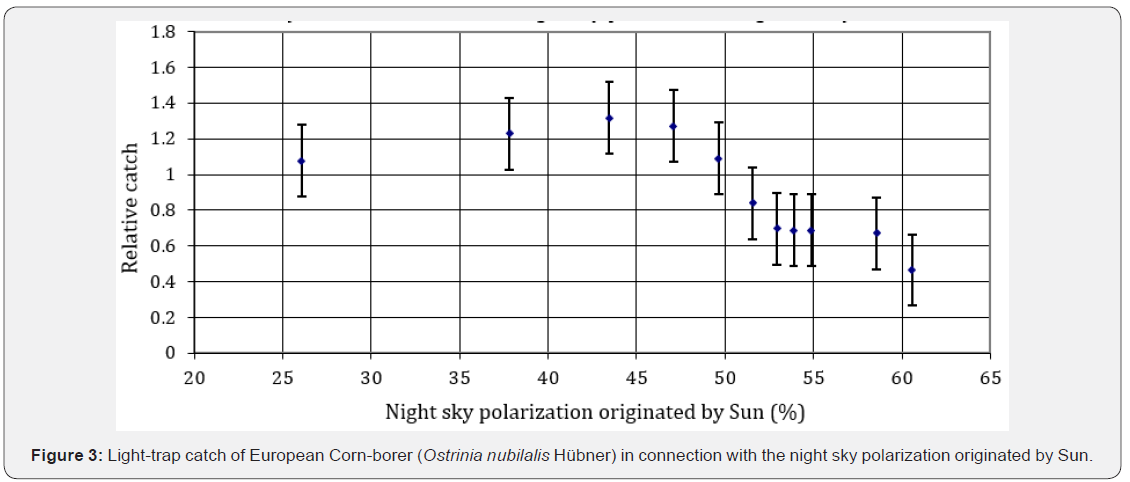
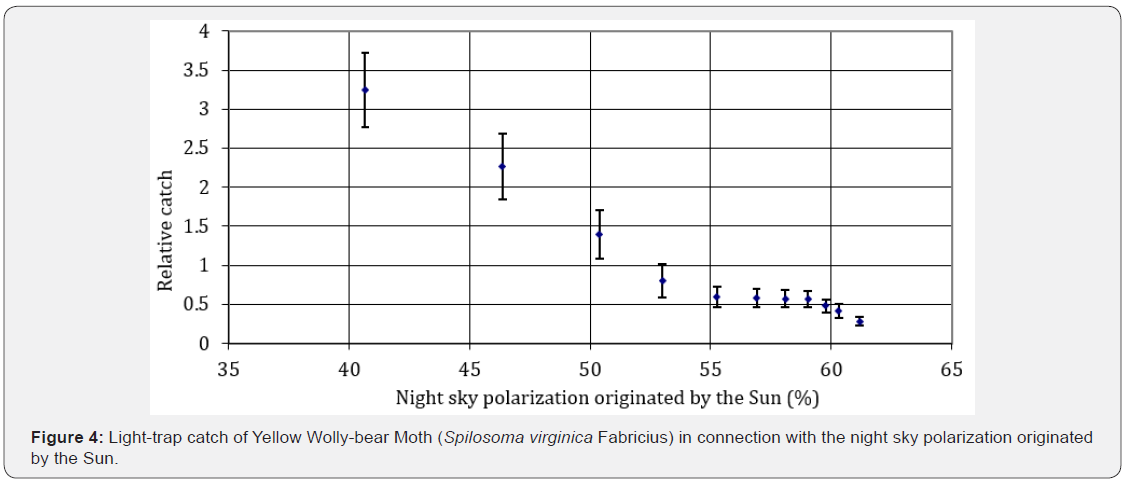
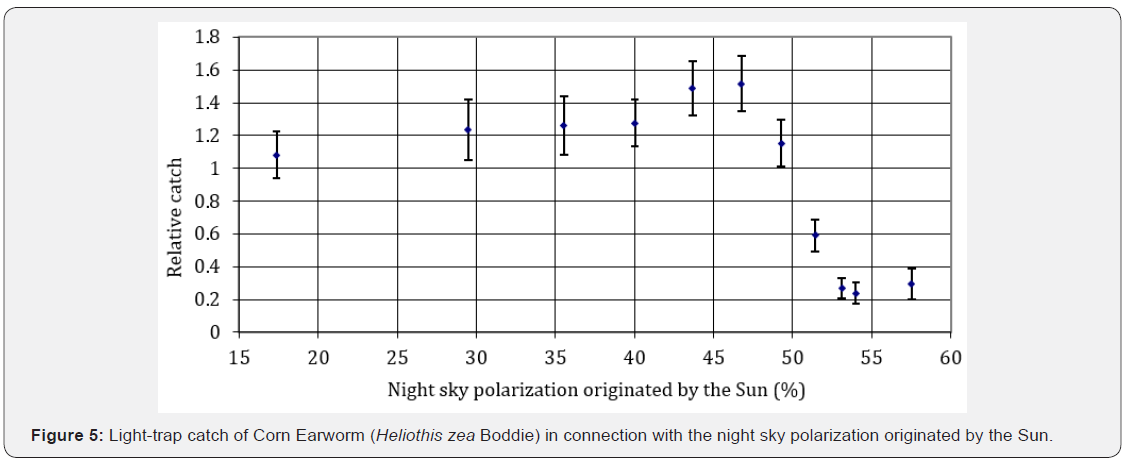
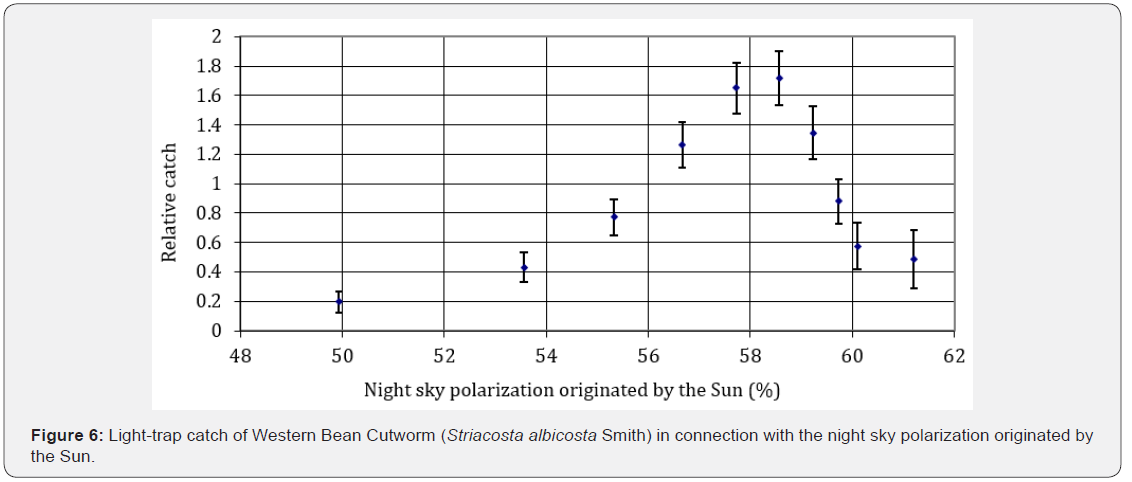
The polarization of the night sky originated by the Sun is different from each of the midnight hours of collecting periods. We believe that the most successful catch of each species has different polarization values. From this fact we conclude that the peak of the swarming of each species is closely related to a given value of the polarization in the sky, which is related to the calendar date. If this is true, then the time of pest species will be more accurate predicted. This is a new result and we did not find any precedent in the literature. Therefore, these should be taken into account when assessing the light trap catch results.
Conclusion
The night sky polarization originated by the Sun can be seen for insects of all the nights, so have an influence in the period. We found that the most successful catch of each species has different polarization values. From this fact we conclude that the peak of the swarming of each species is closely related to a given value of the polarization in the sky, which is related to the calendar date. Our recent work calls attention of entomologists to new and perhaps even more influential environmental factors, the night sky polarization originated by the Sun.
References
- Verkhovskaya IN (1940) The influence of polarized light upon the phototaxis of certain organisms. Bulletin of Natural History Society Biological Section Moscow, 49: 101-113.
- Dacke M, Baird E, Byrne M, Scholtz CH, Warrant EJ (2013) Dung beetles use the Milky Way for orientation. Curr Biol 23(4): 298-300.
- Horváth G, Varjú D (2004) Polarized light in animal vision. Springer Berlin Heidelberg, pp. 447.
- Nowinszky L, Kiss M, Puskás J, Barta A (2017) Light-Trap Catch of Turnip Moth (Agrotis segetum Denis et Schiffermüller, 1775) in Connection with the Night Sky Polarization Phenomena. Glob J Res Rev 4(2): 22.
- Nowinszky L (2003) The Handbook of Light Tapping. Savaria University Press, Szombathely, pp. 276.
- Berry MV, Dennis MR, Lee RL (2004) Polarization singularities in the clear sky. New Journal of Physics 6(1): 162.






























